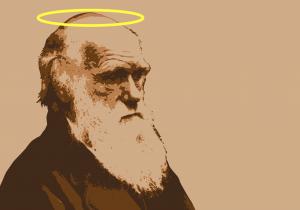 As I wrote recently, the once-fierce cultural hostilities between religion and science have recently mellowed. After being at each other’s throats during most of the 2000s and 2010s, Enlightenment rationalists and religious traditionalists have found themselves surrounded together by the shock troops of postmodern mysticism, who nimbly conquered the entire countryside while no one was looking. Erstwhile foes have started looking like potential allies — fearing imminent social chaos, some influential rationalists have even begun toying with a return to church. But in my view, deep epistemic and cultural tensions remain between religion and science. Instead of sidestepping those tensions, I want to write about how I, both a believer and a human evolutionist by training, reconcile my work with my faith.
As I wrote recently, the once-fierce cultural hostilities between religion and science have recently mellowed. After being at each other’s throats during most of the 2000s and 2010s, Enlightenment rationalists and religious traditionalists have found themselves surrounded together by the shock troops of postmodern mysticism, who nimbly conquered the entire countryside while no one was looking. Erstwhile foes have started looking like potential allies — fearing imminent social chaos, some influential rationalists have even begun toying with a return to church. But in my view, deep epistemic and cultural tensions remain between religion and science. Instead of sidestepping those tensions, I want to write about how I, both a believer and a human evolutionist by training, reconcile my work with my faith.
I haven’t written much about my personal beliefs here over the years, because those beliefs were evolving dramatically, and quite frankly they were no one else’s business. But questions about faith and science are particularly interesting and juicy when it comes to evolution, especially human evolution. So I thought I’d tackle an interesting and thorny problem in religion and science while offering a personal perspective on the evolutionary human predicament.
“Intelligent Design”
This idea was sparked when a friend, a fellow parishioner and university professor, recently sent me a link to a debate about the problematic concept of “intelligent design.” Intelligent design (or ID for short) is the claim that scientific evidence contradicts standard evolutionary theory, in which mutation and selection processes lead to macroevolutionary changes. Instead, ID theorists claim that the objective evidence supports the existence of an “intelligent designer” who somehow guides the show.*
As the title of one recent book demonstrates, proponents of ID see a creator God as a viable scientific hypothesis, to be tested in the same way as other hypotheses. They see the God hypothesis as the only reasonable scientific solution to tricky problems such as the origin of biological information codes (DNA and RNA) or the apparent functional design of “irreducibly complex” biological structures like bat wings.
God of the Gaps
Intelligent design is yet another entry in the long list of “God of the gaps” arguments, which appeal to an omnipotent creator to explain particularly intractable scientific problems. God of the gaps arguments have an illustrious pedigree. Isaac Newton, whose mathematical models of gravitation suggested that planetary orbits should lose stability over time, believed that God must somehow reach into the cosmos occasionally to nudge them back into place. Later research proved him wrong on that point, yet other scientists and thinkers continued to appeal to God in their own explanations of persistent physical mysteries.
But God of the gaps arguments suffer from serious problems. The first is that, the more scientific advances solve once-intractable mysteries, the less “room” there is for God. By pinning your theistic hopes on whatever murky, unconquered dark spots remain in the empty fields of the cosmos, you run the risk of having your faith obliterated whenever some genius finally shines a spotlight into the shadows. Given the inherent unpredictability of scientific breakthroughs, you’d have to be very lucky indeed to pick the “right” gaps to ensure that you’ll never be disillusioned.
The second problem with God of the gaps arguments is that they’re unscientific by definition. This is because, as modern science developed, philosophers and scientists gradually converged on the agreement that rigorous scientific explanations couldn’t appeal to intentional causes or spiritual agencies. This insistence on the impersonal and objective nature of scientific hypotheses came to a head in the 19th century in debates about “vitalism” — the claim that an irreducibly spiritual element underlies biological life, making biology fundamentally different from physics. Advocates of vitalism decisively lost these debates when experimental research successfully reduced a wide range of biological functions — from the production of organic compounds to the regulation of cell development — to chemistry and, from there, to physics.
In other words, biologists found that naturalistic assumptions led to better, faster scientific progress than spiritual ones.
Accordingly, the very framework of scientific naturalism today insists on impersonal, physical laws and forces as the only legitimate explanations for how things work. In field after field, science advances when it uses naturalistic assumptions, but stagnates whenever someone tries to smuggle supernatural or vitalistic ideas back into it.
In other words, when we methodologically assume that the web of physical causes and effects is complete, coherent, and internally definitive within the perceptible cosmos, we find ourselves making progress and formulating testable hypotheses and theories. Most of those theories end up being wrong, of course, but we only find this out because we’re bold enough to formulate them in the first place. We then test our ideas against all sorts of evidence — lab experiments, mathematical modeling, fieldwork observations, ice core measurements, you name it. Again, these ideas often fail. Properly chastised, we come up with new theories which are hopefully a bit better, eventually converging asymptotically on what Socrates would have called “something like the truth.”
The Scientific Image
Methodological naturalism underlies what the philosopher Wilfred Sellars called “the scientific image.” The scientific image — how the world appears through the lens of science — boasts some unique characteristics (my list, not Sellars’s):
- Causes and effects that run in only one direction — from the past to the future — without any purposes or goals. Lacking even a hint of teleology or purpose, nature seen in this way is raw mechanism, an infinity of metaphorical billiard balls clacking mindlessly against other billiard balls, forever.
- This lack of purpose means that agency and will are illusory. After all, the very concept of personal agency — desiring something and then freely acting to bring that thing about — implies a purpose or goal. But purposes and goals are precisely what the scientific lens filters out. Sure, biologists and psychologists sometimes provisionally talk about the intentions and goals of humans and other animals. But they do this for convenience. When neuroscientists and biochemists actually study the low-level processes that produce biological motion, this talk of goals and purposes quickly evaporates: the exchange of potassium ions leads to the firing of a neuron, which leads to a cascade of other neuron activations, which actuates muscle-fiber cells, causing a hand to grasp a cup. At the most basic levels, the scientific image reveals biological beings as organic machines, just as philosopher René Descartes argued in the 17th century.
- Accordingly, scientific naturalism is reductionistic. It prioritizes parts over wholes. Once again, Descartes helped lead the way, calling for science to solve problems by carving them into pieces and learning how the pieces fit together. Reductionism eventually ingrained itself into the very hierarchy of scientific disciplines. Complex, higher-level phenomena such as human psychology or forest ecosystems are thought to “supervene” or depend on the lower-level mechanisms of biochemistry, chemistry, and physics. Scientific progress thus depends on finding lower-level explanations that unify more and more sectors of reality into simpler, more pristine models.
- Finally, the scientific image eliminates individual perspectives or subjective points of view. It aims at what the philosopher Thomas Nagel calls “the view from nowhere.” Early modern philosophers such as John Locke characterized this aspiration in terms of a difference between quantitatively measurable “primary” qualities — for example, length, velocity, and mass — and subjective “secondary” qualities: color, taste, pleasantness, and so forth. Focusing strictly on primary qualities was supposed to emancipate us from messy subjectivity as we explored the physical universe.
Le Sombre Abîme du Temps
Today, when we use these powerful naturalistic filters — lack of purposes or goals, impersonal mechanistic determinism, reductionism, and non-perspectival, quantitative abstraction — to study, say, outer space, what we find is a 13.8-billion-year-old physical universe that is expanding in all directions, where stellar fusion and supernovae spew forth the heavy elements necessary for new solar systems that might eventually host life. The entire show is gradually bending toward entropy, culminating in cosmic heat death in the unimaginably distant future. Even now, the vast majority of the universe is empty space and dark matter.
When we turn these same filters onto biological and even human life, what we find is a world of undirected evolutionary processes, belching out life forms and allowing only the most fit to survive.
This scientific image of life is deeply alien to our experience of life as personal beings. Our familiar, comforting experience of a living, first-person world filled with colors, sounds, motives, emotions, fear, hopes, and affections dissolves, giving way to a third-person view of life as a mindless sorting machine, a vast, heartless winnowing process in which statistical processes of birth, predation, and death sift “successful” organic blueprints from “unsuccessful” ones — the only criteria for success being viable reproduction.
It’s an inherently meaningless, ruthlessly beautiful, profoundly eerie, and completely impersonal vision of the organic world. It all adds up to what the philosopher Charles Taylor (borrowing from Paolo Rossi) calls “the dark abyss of time:” an impersonal universe, older than we can fathom, at its heart completely alien to humans and their insignificant hopes. As the evolutionary biologist Richard Dawkins wrote:
The universe we observe [through the lens of science] has precisely the properties we should expect if there is, at bottom, no design, no purpose, no evil, no good, nothing but blind, pitiless indifference.
Christian Resistance to Evolution is Rational
The coldness and alienation of this vision helps explain why so many Christians have resisted evolutionary theory since the publication of Darwin’s On the Origin of Species in 1859. Christianity in all its forms teaches that humans are personal beings made in the “image” of God — that is, we share God’s rational, creative, and ordering powers. A moment’s reflection reveals that we cannot be both this and nothing but a collective of genes struggle to propagate themselves. The visions are intrinsically incompatible. Many conservative Christians have been more honest and direct about this incompatibility than respectable liberal or mainline Christians, who often wave aside the dark existential implications of Darwinian theory in order to preserve the up-to-dateness of their views.
But while conservative Christians are perfectly correct to identify a deep tension between evolution and traditional theology, many choose theology at the cost of denying well-established biological facts about the nature and origins of humanity. Evolutionary theories are essential for all biological research, after all; they’re not optional add-ons. The biologist and Orthodox Christian Theodosius Dobzhansky quipped that “Nothing in biology makes any sense except in the light of evolution.” Humans are biological beings. This dictum applies to us too.
Humans and Birds
For example, when we compare the brains and cognitive abilities of different primates, we gain a fairly good (not complete, but good) picture of how, over eons, the human brain developed the unique abilities that distinguish us from other apes: gestural and verbal language; extraordinarily rich social cognition; exquisitely fine timing systems for motor control; inhibitory self-control; highly developed abilities and motivations for imitation. Other primates show progressive hints of these abilities, suggesting the gradual evolutionary development of distinctive abilities like motor synchronization (keeping together in time). But only humans have the full package.
Yet many of the most striking similarities aren’t between humans and chimps, but between humans and birds, particularly songbirds. As I’ve written before, vocal learning — the ability to hear, mimic, and then rehearse the vocalizations of others — is crucial for both human language and the complex calls and songs of songbirds. Thus, while birds don’t have language proper, their brains are much more similar to ours in terms of imitation and auditory-motor skills than those of chimpanzees, which are not a vocal learning species.
When you think about it, this is pretty wild. The most recent common ancestor of humans and birds lived 340 million years ago, long before the Triassic period when the first dinosaurs roamed. Why would we share vocal learning traits with birds, but not with chimpanzees — whose most recent common ancestor with us lived practically yesterday, only a few million year ago?
Two answers are top contenders. First, both humans and most species of vocal learning birds are, by and large, socially monogamous — that is, we form durable mating pair bonds. Yes, many human societies allow polygamy, and couples (both birds and humans) are sometimes unfaithful to each other. But even in polygamous human societies, only a few high-status men manage to acquire more than one wife. The majority of people are limited to one partner. Both birds and humans, then, have psychological adaptations for pair-bonding that chimpanzees lack. Complex vocalization may be one of them, since it’s helpful for maintaining close, pair-bonded relationships in highly social, group-living environments.
A second suggestion is that vocal learning species tend to inhabit three-dimensional environments. In addition to humans and birds, other vocal learners likely include pinnipeds (seals). Birds fly, seals swim, and ancestral homo species likely lived a combined forest-floor/treetop life. In each environment, our partners might be in front of, behind, below, or above us at any given time. While eyesight is able to register light only from whichever direction the eyes are turned, hearing can pick up sounds from any direction. It makes sense that vocal communication would be particularly important and complex for species that need to communicate with their partners across three spatial dimensions.
The remarkable similarities between songbirds’ and humans’ brains are, then, an example of convergent evolution — the same adaptation developing independently in vastly different species in response to similar ecological contexts.
It would be difficult to trace out this chain of reasoning without evolutionary logic, which asks us to work out how adaptations benefit fitness in unique contexts over time. You can’t just assume that all creatures were created in their present form adapted for their unique niches, because our brains and bodies show strong evidence of having picked up different adaptations to changing contexts over evolutionary timescales. The dark abyss of time returns, but this time it bears the gift of knowledge.
Three Strategies for Faith
So what are serious believers supposed to do? Many evolutionary biologists — especially those who work on human evolution — think the answer is simple: stop believing. Humans are clearly not a special creature made in the image of God. We’re an upright ape with some complicated evolved machinery for thinking and speaking. We face the same problems any other animal, such as how to compete successfully for resources and mates, how to strategize our investment in offspring. Science offers no indication that we’re beloved children of God. In fact, the very thought smacks of immaturity, of wishful thinking.
Christians, by and large, obviously disagree with this argument. They take one of three different responses instead. Two are common and one is rare.
The first common response is that of liberal or respectable theology, which I briefly mentioned above. It entails publicly accepting the truth of evolutionary theory while politely avoiding its horrific existential implications. Christians who pursue this strategy might take parts of Genesis (or all of it) metaphorically, or they might shrug and argue that evolution is simply how God created life on earth.
This is fine as far as it goes, until you remember that there are wasps that lay eggs inside of caterpillars which, when they hatch, paralyze their host and eat it alive. (This fact greatly troubled Darwin himself, probably helping nudge him away from Christianity.) Or until you recall that the engine of evolution is, literally, death: you can’t have the progressive tinkering and improvement that evolution demands unless unnumbered hosts of creatures die horribly, twitching out their last in the mouths and guts of predators, leaving behind only the most well-adapted to carry on the gene line. Of course, even these lucky survivors only live long enough to pass on their genes. Then they die too. Usually horribly.
So the first Christian response to evolution is respectable. It won’t cost you any social points in educated company. But — in my opinion — it risks intellectual and emotional dishonesty. It pretends that evolution is ultimately a nice thing when it is plainly not.
The second Christian approach is the conservative one. It takes several forms, each of which is eventually obliged to reject the science. Some conservatives deny evolution entirely, insisting that the Earth was created only a few thousand years ago with all its creatures in one go. Others believe in an ancient earth and evolution for other creatures, but insist that humans were placed specially here or created specially by God. Others accept microevolution (the adaption of particular traits to local ecologies) but reject macroevolution (the development of new species).
Then, of course, there’s the ID crowd, who might accept an old earth but explicitly deny the basic propositions of evolutionary theory, proposing instead that a divine intelligence designs the most complicated bits of life. We’ve already enumerated the many problems with this view.
The third, uncommon response is to acknowledge that the science is getting at the truth, and the truth is deeply uncomfortable — and then to push forward in faith anyway, and see what happens. In my experience, what happens is that reality progressively reveals itself to be much richer and more complex than either science or naïve reason would suggest.
Second Naïvety
How could an intellectually honest person “have faith” with integrity, when the scientific image of humankind is so powerfully predictive, useful, well-supported, and existentially troubling? Isn’t the admonition to have faith in the face of the scientific image simply a request to return to naïvety?
No. The philosopher Paul Ricouer distinguished between “first naïvety” and “second naïvety” in religious beliefs. First naïvety is truly, well, naïve. It entails a kind of ignorance, maybe even willful ignorance, of the unpleasant and disillusioning facts about the world. Faith based on first naïvety is shallow and fragile. Any disillusionment can be fatal to it. Parasitic wasps, for example.
Second naïvety comes only after disillusionment. As one rebuilds one’s faith, it can — not will, but can — become stronger and more robust, in part because it’s been previously broken down. This process entails a richer view of the doctrines of the faith, combined with a steely understanding that world isn’t built to please us. It frequently involves a layered understanding of scripture, accepting many levels of meaning — literal or metaphorical, moral or analogical — at the same time.
My view is that second naïvety is impossible, or at least very hard, without rigorous religious practice: regular prayers, disciplines, liturgy. These are things you do consistently whether you especially feel like it or not. This explains why so many low-church Protestants — the Evangelicals and fundamentalists who make up much of the American church — seem to have trouble attaining second naïvety. Their traditions are very heavy on intellectual propositions and, in some cases, emotional highs, but intentionally light on, even ideologically opposed to, spiritual disciplines or liturgy. Once disillusion sets in, their faith tends to fall apart. As a result, they tend to studiously avoid the dark abysses of science, rejecting potentially discomfiting findings.
The third Christian response to evolution depends, then, on making the faith into a way of life, one that you persist in even when you inevitably encounter facts or findings that inspire doubt. First naïvety treats religious faith as a child treats a parent — trustingly assuming that everything the parent says is true and objective, standing in a relation of dependence and helplessness. Second naïvety is more like a marriage. You commit to it knowing that there will be ups and downs, that there may come days or years when only the commitment itself keeps you going. But each period of drought eventually ends, often leaving the marriage refreshed, reinvigorated. Slowly, over the course of decades, you learn to trust that dark tunnels reliably open up into light.
Parameters and Plausibility
But nobody makes big commitments without a reason. You marry the person you suspect will be be compatible with you over the long term, somebody you can envision making a life with. You convert to a religious tradition because, at some level, the worldview it offers seems compelling and plausible given what you know of the world.
This question of plausibility is is obviously a common sticking point. The scientific and evolutionary view of human existence and the universe seem to make the Christian worldview appear desperately implausible. However, I think this impression emerges from the axioms of science, not from its findings. Remember the basic assumptions that delimit the scientific image: purposelessness, impersonality, reductionism, and perspectiveless abstraction. We take these axioms for granted in order to do scientific research.
They aren’t products of science, then. They’re its parameters.
Instead of questioning the results we get from within those parameters, we can — if we want — question their comprehensiveness. This might be analogous to taking off a pair of polarized sunglasses on a sunny day. The lenses undoubtedly improve our vision in many ways. They make individual things sharper, clearer, more distinct. But they also remove color and alter the tint. If we want to know the color of a certain flower, we peer around the rim of the glasses.
Abstractions and Models
Let’s home in on the fourth assumption of scientific naturalism: perspectiveless abstraction. The abstractions that make up the scientific image are useful, necessary, and often true. I’ve never seen a hydrogen atom (and neither have you), but I believe that the sun is composed largely of hydrogen, because this belief leads scientists to make accurate predictions about how the sun works.
Yet by their very nature, scientific abstractions can’t encompass the full scope of reality. This is because reality also necessarily includes the very things that scientific naturalism is designed to filter out — such as personal perspectives.
Imagine that you’re out hiking one morning in Colorado. The mountain you intend to climb rises in front of you, dotted with pine forest and granite ridges, glowing slightly golden in the early-morning light. The sight fills you with awe.
But the impersonal scientific image of the mountain contains no golden light or awe. In fact, there are many “scientific images” of the mountain. One of them shows a geological structure composed mostly of granite and metamorphic rock, the result of eons of glacial erosion. Another focuses on the complex ecology of the mountain’s Ponderosa pine forests and alpine meadows, tabulating the numberless species and their dynamic relationships. A third meteorological image represents the mountains’s effects on weather systems.
All of these scientific images are impersonal and reductionistic. They don’t invoke agencies or spirits. But most importantly, they’re abstractions. Instead of sights, sounds, and impressions, they offer quantified models.
The View from Somewhere
Yet as philosophers from George Berkeley to Thomas Nagel have pointed out, all scientific abstractions begin in somebody’s phenomenal (perceptual) experience. Scientists who are living human beings look through radio telescopes, measure soil acidity, or observe animal behavior. They might even run computer simulations. But at the end of the day, any new discovery in science means that a real pair of human eyes (or ears, or whatever) experienced something.
Human observers are prone to error and bias. As Nagel observed, the quest for objectivity in science means trying to squeeze out all of the subjective fuzziness out of our models. From where I stand, a mountain looks like a jagged, triangular peak, topped by a rocky cliff. But to you, over on the east side, it looks like a mellow, rolling hill. Which of us is right? Well, the mountain as an objective entity contains both sloping and jagged faces. No human being could see all sides at once, so we have to use abstraction — say, a topographical map — to take account of all its crevices and shapes simultaneously.
The inherent limitations of first-person points of view have led our modern civilization to assume that the abstractions of science are more real than the experiences they build on. But Nagel says no, this can’t be true. Subjectivity is real, even though it’s not objective. How else could we ever have arrived at scientific abstractions in the first place? As our view of the world becomes more objective, it strangely loses its competence to account for the primary source of all of our information about it. As the Spanish philosopher José Ortega y Gasset insisted,
Perspective is one of the components of reality. Far from being its deformation it is its organization. A reality which would remain always the same when seen from different points is an absurdity.
So while our personal, limited perspective on the hypothetical mountain is always incomplete, it’s also real. And while our 3D model of a mountain is more accurate, topographically, than the limited view from the road far below, it’s also more abstract. Standing at a scenic lookout, we see speckled rocks, a mixture of pines and aspens, a few bighorn sheep moving across clearing far above. The topographical map shows us relief and elevations far more accurately than our naked eyes do, but it shows us nothing else — no speckles, no aspens, no sheep. We gain accuracy at the price of complexity, pristine regularity at the price of spontaneity.
We Are Real
The view from nowhere is clearly more objective than the view from somewhere. Objectivity depends on moving away from the limitations of any given, particular point of view. But in so doing, it loses grip on any aspects of reality that depend on unique perspectives. The implication is that “objective” isn’t synonymous with “real.” Reality itself — the whole shebang — necessarily includes both subjective and the objective poles.
Religious faith, then, isn’t a retreat to pure subjectivity (as you might have feared I was about to argue). Instead, I see it as an attempt to contend with the whole of reality. In this way it’s unlike science, which is intentionally designed to concern itself only with the objective pole. Conversely, various intellectual movements — 19th-century Romanticism, maybe, or some versions of Continental phenomenology — have restricted themselves largely to the subjective pole. But rigorous faith acknowledges that the real world exists at the intersection between subjective and objective, where the first and third persons meet.
When we mistake scientific naturalism for reality itself, we begin to suspect that we, as persons, don’t really exist. How could we not? The first person is scalpeled out of the scientific image. So are goals and purposes. Everything that defines us as persons is ruled out. If the scientific image is more real and true than our everyday experience, we must conclude that our existence as personal agents is ultimately an illusion, a falsity. Various serious thinkers, such as Daniel Dennett and Patricia and Paul Churchland, have argued for versions of this claim.
But if reality encompasses both the objective and subjective poles, then our personal existence might be real after all. To return to the question of plausibility, I think the path to plausibility for a Christian worldview lies in living as if this possibility were in fact true — taking as a working hypothesis the strange proposition that human beings are real. Not just as agglomerations of cellular tissue and carbon chains, of DNA and peptides. But as persons.
The World Is a Story
When we live as if our lives and personhood were not eerie illusions but real elements of the world, what we find is that the world we actually encounter — not the objective one we model with abstractions — tends to behave more like a story than like a machine.
Characters in a story have ambitions and fears, intentions and purposes. Things happen to them not just because of mindless material causes, but because those things somehow contribute to the unfolding of the narrative and its meaning. And perhaps most importantly, every element in the story — each character, object, conflict — stands for both itself and any number of other things. In other words, narratives are symbolic.
As a young man, the philosopher and psychologist William James found himself crushed with the depressing sense that it was scientifically impossible to have free will. He broke free of this deterministic worldview when he decided to simply act as if he had freedom. Resolving the endless contradictions between scientific and theological takes on the human condition hinges on running a similar experiment in our own lives.
If you’re so inclined, think and act as if you were real. Assume that the scientific image is powerful and accurate but inherently incomplete by design. Remember that reality is richer than abstractions, and almost invariably more unexpected. Entertain the possibility that things possess both a material nature and a meaning — that they can point beyond themselves.
In my own experience, this strategy leads to a growing impression that human life is in fact a meaningful story. Science discovers and describes the parameters for the world in which the story unfolds, but it doesn’t do much to illuminate the symbols or meanings of the episodes and motifs. It’s a good tool for getting around the world of the story and for manipulating its affordances. But it can distract us from narrative immersion, from participating in the arc of the story. And immersion is the only way to learn what the story is really about.
This strategy so far doesn’t lead necessarily to a Christian interpretation of the story. I happen to think that the Christian story maps onto the story of life better than all the other options. But going into why would require another essay. The point of this one is to outline how I take evolution, particularly human evolution, seriously enough to use evolutionary reasoning as the root paradigm for all of my academic research, while also being someone who lives a life of faith and participates in regular spiritual practices and disciplines that would make little sense if scientific naturalism were comprehensively true.
Seen through a scientific lens, we’re pretty clearly descendants of a common ancestor with other great apes. Evolution works as a system of beliefs that links up the biological facts about human life with the observable and recordable facts about biology in general and the geological record. It shows that we are, in the words of Solomon in the Book of Ecclesiastes, “like the animals.” We share our biological predicament with other creatures. We face the same pressures to survive, mate, compete. We’re embedded in a long and apparently purposeless march of eons, just as they are.
But the purposelessness and eeriness of this scientific image don’t just fall out neutrally from the science. We ourselves imported them into it with our naturalistic assumptions, which were necessary for doing good scientific work even as they blinkered out the narrative and personal dimensions of life. Scientific findings are therefore partial truths. They are more objective than any other kind of knowledge, but objective isn’t synonymous with real. Neither is subjective. Reality is where the two meet. In my experience, living in reality — as opposed to living in abstractions or in subjective solipsism — unexpectedly makes faith more plausible, not less.
Pure subjectivity is nothing but impulse and impression. It terminates in chaotic disconnect with the facts of the world. Conversely, pure objectivity is flatness and abstraction. The most purely objective view of anything can never be actually experienced by anyone. It isn’t quite real. Living in reality requires us to take both experience and models seriously. It offers what the physicist and Anglican priest John Polkinghorne called a “stereoscopic” view of the world. Looking through the left eye, you see one view of the mountain. Looking through the right eye, you see another. Looking through both, you get the complete picture. And surprise of surprises — the world turns out to be three-dimensional.
_____
* Proponents of ID claim to be agnostic about who the “designer” is, but everybody knows they’re talking about God, and more specifically the biblical God. I’ve never understood why they don’t just come out and say that, but they foolishly neglected to ask for my input in the matter.












